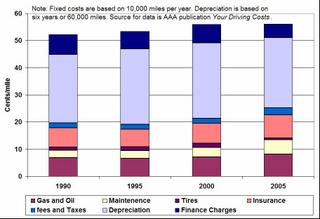Over the weekend, the NYT published
a bunch of articles about increasing gasoline prices under a title
Beyond Gasoline. I want to talk about just one titled
The New Prize: Alternative Fuels written by Danny Hakim. The "old" Prize being reference to oil as made famous by
Daniel Yergin's book. In particular, I want to focus on the chart that was pulished along with the article:
Using Less Gas, or None at All. As I looked at the graphic, which I think is presents a balanced picture, I wondered why they chose to ignore both diesels and conventional hybrids in the graphic. Now, Diesel is a little more expensive than gasoline in the US, and hybrids still use a lot of gasoline. Yet, both of these technologies have a significant potential to improve upon mainstream ICE gasoline vehicles. These improvements are on the order of 25-30%, and these vehicles are available today.
I also wondered perhaps failure to mention hybrid in this chart means that hybrids are already a "mainstream" technology in some sense? Afterall,
hybrid sales have shown a robust growth in the past year, even though the numbers are still small in absolute sense. Prius is already selling at 100,000 a year mark, a production level for which many of the new models are designed for. Still, hybrids are just 1% of new vehicle sales in the US market.
Then, as one thinks about the examples used in the article one starts to get a sense of what all of this is about. It is about an old American dream that is America can be Energy Independent, and Americans can keep driving their large, heavy and powerful vehicles around at the same time!
"One of the customers drove about 30 miles to the station; she said: 'I'm putting my dad's corn in the car. I'd rather do that than pay OPEC,' " Mr. Cobb said.
... In Madison, Wis., Rebecca Bell and her husband, Kevin, started using E85 in the last couple of weeks to fuel their Ford Explorer and their Chevy minivan. They have also started carpooling with neighbors.
Yes, as the article and
In the Tank Report note, there has indeed been a modest shift from SUVs to CrossOver Utilities, BUT pickup and large van sales have been largely unchanged. The trend towards CUVs, I could argue, had started a couple of years ago (
Ford think so too, see slide 11), and has perhaps little to do with the recent increase in gasoline prices.
The point I want to drive home is the following: Think about it in very simple terms. How about we make 90% of our vehicles 20% more efficient, as opposed to 10% of the vehicles 50% more efficient? By doing the first, we will get roughly (far from exact) 18% gain where as doing the second gets us 5% improvement. How about we start thinking about driving slightly smaller, lighter and less powerful GASOLINE (conventional or hybrid) or DIESEL powered vehicles which at the same or lower cost deliver 20% more fuel economy? We may be able to derive fuel saving benefits sooner than tinkering with plug-in hybrids or waiting for Fuel Cell Vehicles. The technology is with us in a very real sense as opposed to say fuel cell vehicles or even plug-in hybrids. May be the real prize is still the "old" prize. Perhaps, we just have not understood the value of the prize. YET.




